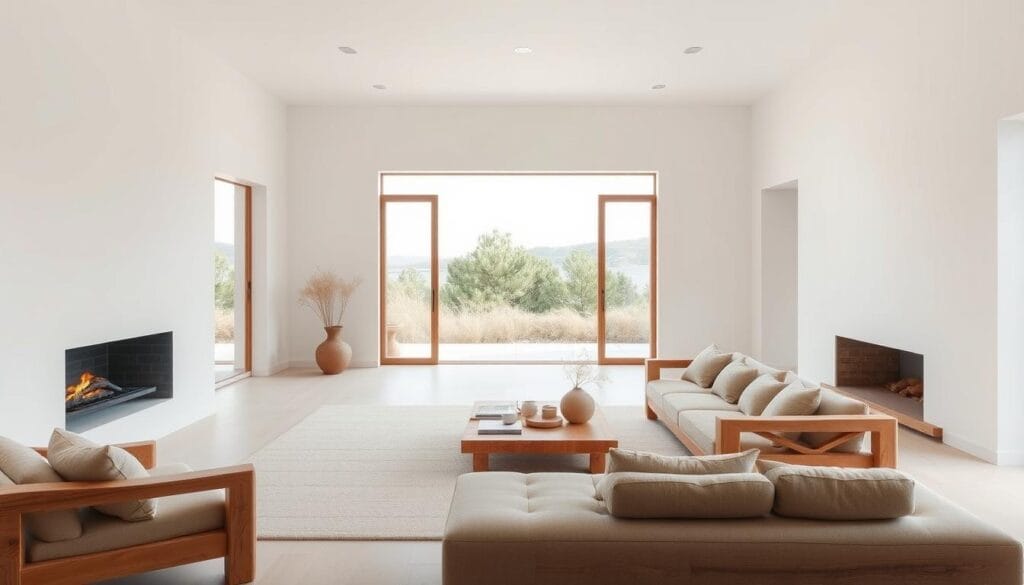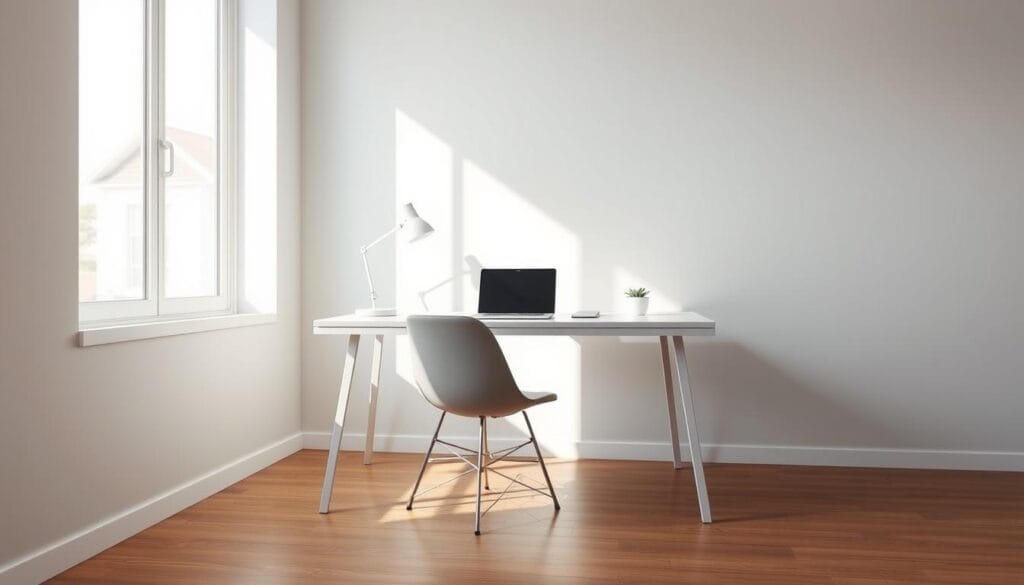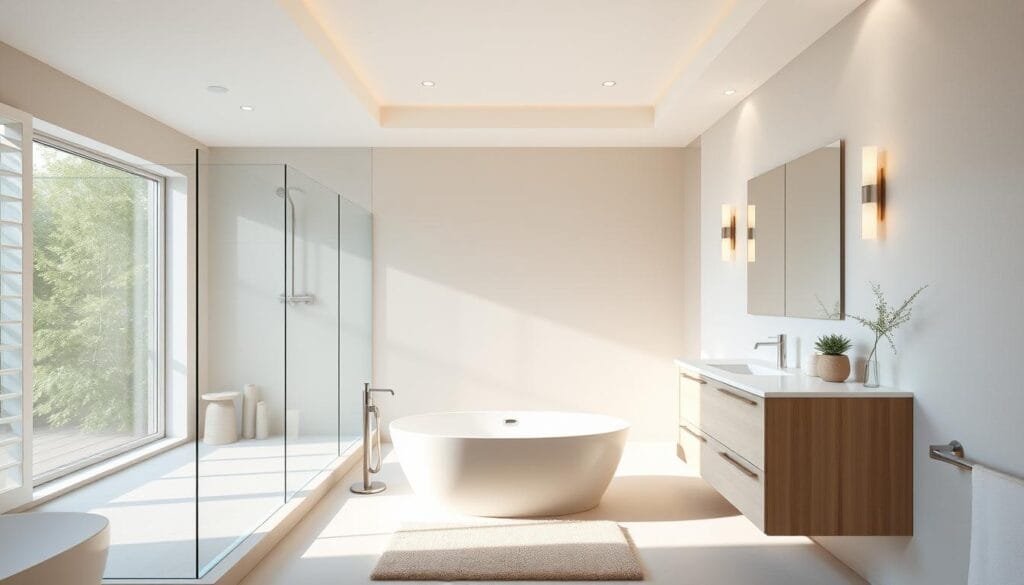Welcome to our guide on minimalist house design interiors. Here, you’ll learn how to make your living spaces calm, serene, and modern. Imagine coming home from a busy day to a place of simplicity instead of clutter. With fewer items, your home becomes a calming space that refreshes your mind and heart.
Think about having a cozy spot for reading, a Zen bedroom for peaceful sleep, or a simple kitchen that makes cooking fun. Zen focuses on simplicity and meditation, helping to create a calm home. Homeowners now enjoy spaces that serve multiple purposes, like yoga studios or fold-away bars, adding beauty and function to their homes.
In this guide, we’ll share helpful tips and ideas for every room. We’ll help you pick neutral colors, versatile furniture, natural elements, and smart storage. We aim to help you find the beauty in simplicity. Let’s create your modern, peaceful home together!
Understanding Minimalist Design Principles
Today, choosing minimalist interior design is more than liking a style. It’s about a life choice. After World War II, the minimalist art movement influenced this design greatly. By the 1980s, it became a popular way to push back against city life chaos.
The heart of minimalist design is all about keeping things simple, usable, and with purpose. It aims to make spaces calm yet useful.
The Essence of Minimalism in Interiors
The core of minimalist interior design is the idea that “less is more,” as Ludwig Mies van der Rohe once said. This means you pick items that are beautiful but also useful. Clean lines, spacious layouts, and lots of natural light are key.
Every piece in a room is chosen carefully, making the space look clean and important. Choosing minimalism means you live with only what you need, avoiding clutter.
Key Elements of Minimalist Design
Minimalist design’s main ideas show through its basic parts. These parts are:
- Simple lines
- Limited furniture
- Minimal decorative objects
- Open floor plans
- Emphasis on natural light
These elements work together to lower visual clutter and make your home more beautiful. With clever storage ideas, minimalist rooms stay tidy and nice to look at. Using mainly one color scheme with a few color pops can make a place feel peaceful.
Benefits of a Minimalist Approach
Choosing minimalist design brings many perks, appealing to lots of homeowners. It creates a tidy space that eases stress. With fewer things, you have less to clean and maintain, boosting productivity and focus.
Minimalist living also leans towards being eco-friendly. It encourages buying less and wasting less. This design style makes your home a calm escape from busy daily life.
Truly understanding and using minimalist design principles can make your living space a place of peace and calm.
Color Schemes for Minimalist Interiors
Choosing the right colors is key for a minimalist home. Minimalism shines with serene colors that bring calm and open space. Let’s look into how different colors can change your room.
Neutral Palette Choices
Neutral colors like white, gray, beige, and taupe are basics for minimalist style. They help rooms feel big and light. White is great for making spaces feel larger, especially in living areas and kitchens. Gray adds elegance with cool and warm tones.
For bedrooms, colors like pale blue, lavender, and warm beige are best. They help you sleep better and keep things calm. For kitchens and dining areas, using white, gray, and light wood tones keeps the space fresh. Explore more about using these colors for a calm home.
Incorporating Bold Accents
Minimalism isn’t just neutral colors; bold accents are also used. A bit of bold color adds excitement and focus without being too much. Bold jewel tones like Beau Green or Starry Night Blue can make a space lively and interesting.
For a less bold option, try muted earth tones or soft pastels. These colors keep the minimalist look but add depth. This mix of neutral and bold colors can make your home’s design features and art stand out beautifully.
The Impact of Light and Dark Colors
Using light and dark colors wisely is important in minimalism. Light colors make rooms feel bigger and brighter. Simply White OC-117 by Benjamin Moore is a favorite for its flexibility.
Dark colors like Black Tar add drama, especially in modern spaces. Mixing white with dark colors gives a sleek, modern vibe. Adding finishes with sheen brings texture and enhances minimalist design.
Furniture Selection for Minimalist Spaces
When picking out furniture for minimalist rooms, aim for both usefulness and good looks. Each item needs to add to the calm and smooth feel of the space.
Choosing Multifunctional Furniture
In today’s minimalist style, furniture that serves more than one purpose is key. For example, a sofa that turns into a bed or a table that gets bigger saves space. Plus, it keeps things simple and clean. A 4-in-1 sofa bed, for instance, can make a small living space way more useful.
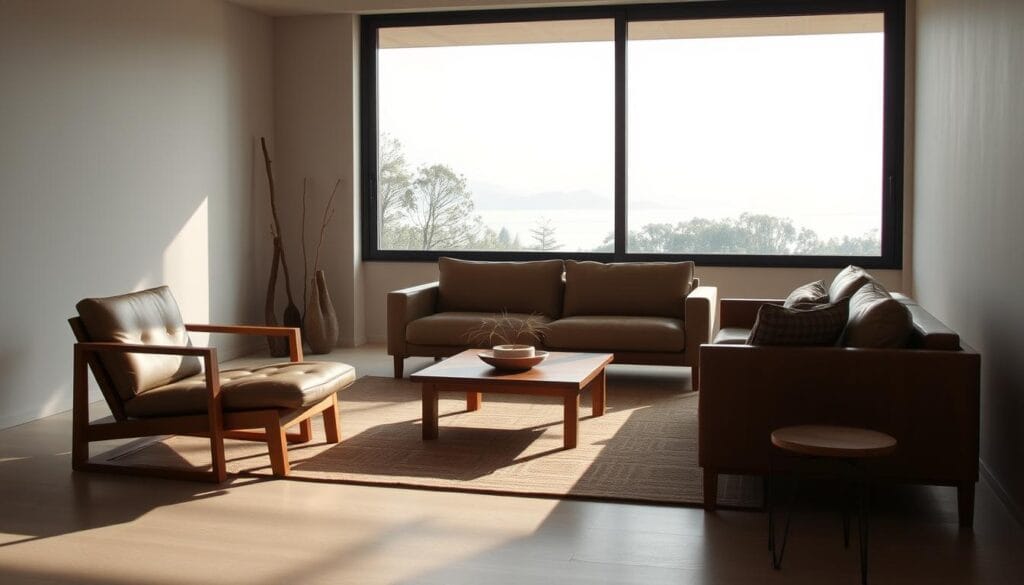
Importance of Scale and Proportion
Getting the size and shape right is crucial in minimalist design. You have to think about how big the room is to pick the right furniture. This way, everything fits perfectly. Using shorter furniture makes the ceiling seem taller. This trick makes the room look bigger and keeps it simple.
Top Brands for Minimalist Furniture
Brands like IKEA and Muji lead in minimalist furniture. Their designs are simple yet practical, fitting perfectly into minimalist rooms. By choosing quality pieces from these brands, you won’t need to shop for furniture as often. This choice not only looks good but also supports a simpler, more sustainable lifestyle.
Minimalist Lighting Options
Minimalist design treats lighting as more than just useful. Lighting shapes the tone and feel of a space. By using minimalist lighting, we make our homes calm and peaceful.
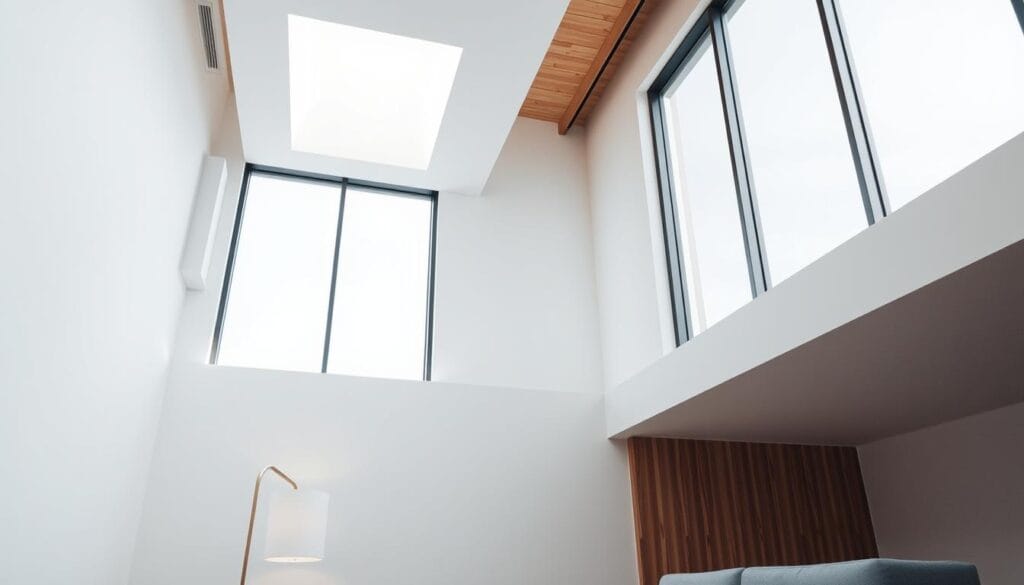
Natural Light: The Ultimate Design Element
Natural light is key in minimalist design. It opens up a room, making it seem larger and brighter. We should focus on big windows and skylights to let in lots of natural light.
Selecting Fixtures that Align with Minimalism
Picking the right fixtures is vital. Minimalist lighting uses simple shapes and colors that fit many styles. The Trikonasana black multi-arm light and Gold Waldorf pendant are great choices. They have clean designs and subtle colors, making sure they enhance not overpower the room.
Tips for Creating Ambient Lighting
Ambient lighting creates a soft, indirect light that fills the room. Mix light sources like overhead lights, wall lights, and lamps for this effect. Dimmable lights, especially in bedrooms, add to a relaxing atmosphere. A well-chosen lamp or chandelier, like those from Casalola Lights, also adds charm without losing the minimalist feel.
Choosing and placing lights right can make a room’s mood better without too much. Minimalist lighting is elegant and can truly change your home.
Creating Open Spaces in Your Home
Open spaces make our homes feel peaceful and free. By making your living areas flow well, your place can feel bigger and more inviting. Thoughtful planning and smart space use are key to this balance.
Importance of Space Fluidity
Open space design relies on fluidity. This means making everything flow together nicely, which makes moving around easier and everything look better. An open floor plan helps with this by making spaces feel bigger and taking away walls that aren’t needed. Going minimal doesn’t mean you lose style—it means everything is clear and works well.
Techniques for Decluttering
Keeping your home minimal takes work. Having a declutter session once a month can keep things neat and calm. The “One In, One Out” rule helps keep things balanced—when a new item comes in, an old one goes. Using the KonMari Method and smart storage, like hidden spots, keeps clutter away and your space clean.
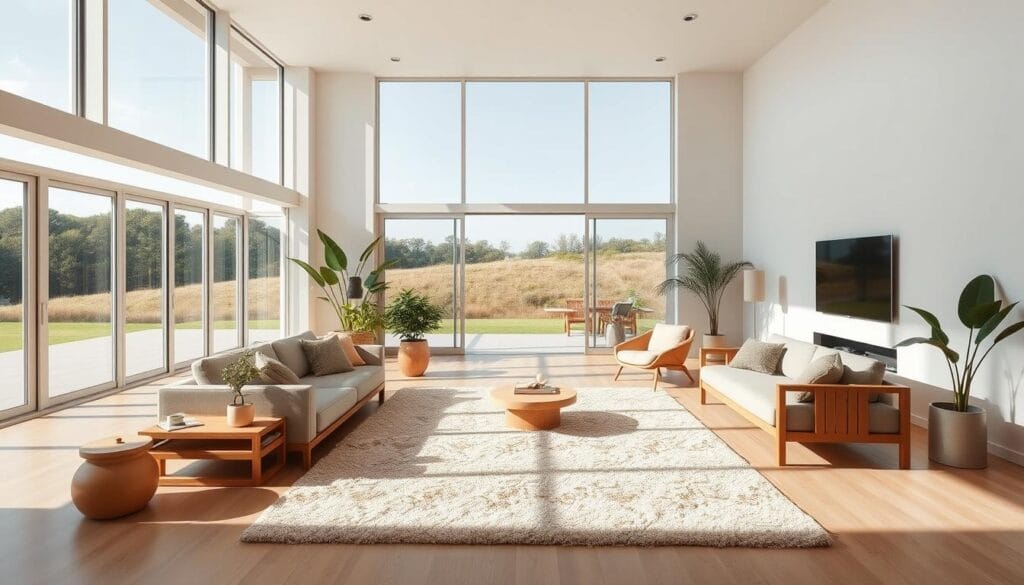
Using Room Dividers Effectively
Room dividers can add to your open space nicely. They split up areas without fully closing them off. Things like sliding doors or foldable screens, or even furniture, can offer some privacy but still let light and air move freely. They’re great for keeping the open feel while also giving some separation.
| Technique | Benefit |
|---|---|
| Open Floor Plan | Enhances spaciousness and coherence |
| “One In, One Out” | Keeps clutter in check and maintains balance |
| KonMari Method | Encourages intentional living and efficient organization |
| Hidden Storage | Maintains a sleek aesthetic while hiding clutter |
| Room Dividers | Defines spaces without restricting flow |
Embracing these elements makes your home calm and open, just like minimalist living aims for. It’s about making a place where everything has a reason and spaces make you feel at peace and connected.
Incorporating Nature into Minimalist Designs
Adding a touch of nature to a minimalist design can make your home more relaxing and beautiful. Using natural elements like wood, stone, and plants helps create a peaceful space. It reduces stress and connects us more with the natural world.
Biophilic Design Concepts
Biophilic design means bringing the outside into your home. This can be done with big windows, materials like bamboo and linen, and placing plants around the house. These changes make our homes look better and feel more peaceful.
Plant Selection for Minimalist Spaces
Choosing the right plants is key in a minimalist home. Go for easy-care plants like succulents, snake plants, or fiddle-leaf figs. These plants keep your space looking neat while improving air quality and adding beauty.
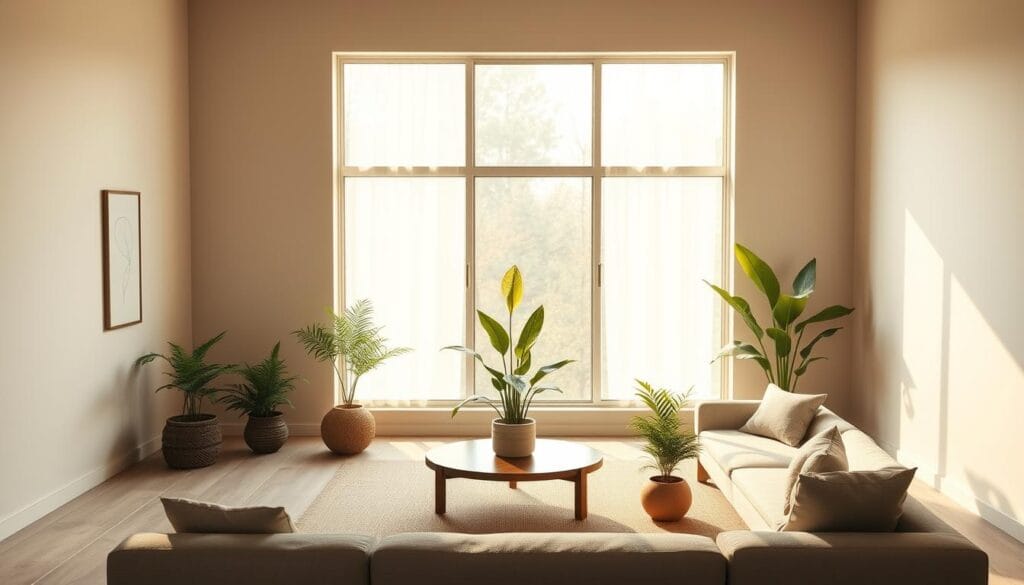
Designing with Natural Materials
Using materials like wood, stone, bamboo, and clay adds texture and warmth. They help balance modern and natural elements in a room. With items like raw wooden furniture or linen drapes, we can make our spaces look good in a sustainable way.
Textures and Patterns in Minimalism
Texture is key in minimalist design, adding depth and making spaces inviting. While smooth surfaces are common, different textures make a room feel warm. This shift from sterile to welcoming is crucial.
The Role of Texture in a Minimalist Room
Introducing textures like linen, wool, or cotton brings warmth while keeping it simple. Textures such as matte paint or seagrass wallpaper add subtle interest. These elements make a space feel inviting yet clean.
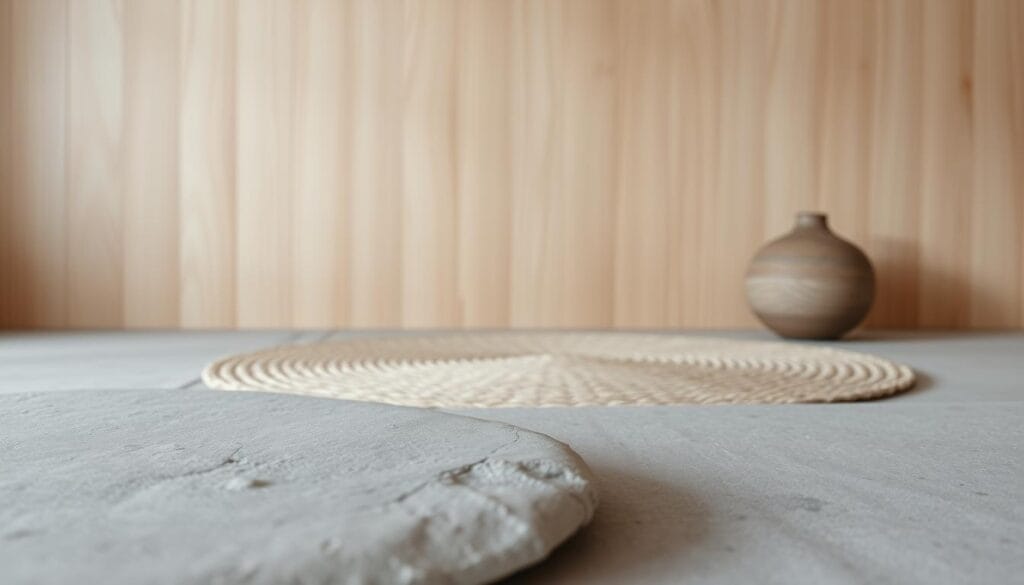
Layers: Mixing Different Materials
Mixing materials like wood, metal, and fabric can make minimalism rich and varied. For example, leather chairs paired with a wooden table add contrast. Adding a wool rug on top of a sisal rug creates a cozy, sophisticated look.
Avoiding Clutter with Patterns
When adding patterns, it’s important to be subtle. Choose simple patterns like soft stripes or geometric shapes. These choices add personality without overwhelming the space. This way, the decor feels serene and uncluttered.
Art and Decor in Minimalist Interiors
Adding minimalist art and decor can make your space feel calming and balanced. It’s all about being thoughtful and picky with what you bring into your home. We’ll look into how to pick the right art, use minimalist decor ideas, and keep your home looking its best.
Choosing the Right Artwork
Your art should fit the minimalist theme. Choose pieces that add peace and interest but don’t take over the room. Fintan Whelan, Don Bishop, and Nadia Attura offer large canvases and beautiful photography perfect for minimalist spaces. For cool minimalist room ideas, check out Artifact Uprising.
Minimalist Decor: Less is More
The “less is more” idea is key in minimalist decor. Choose decor pieces that have a purpose or really stand out. Transparent frames make photos pop by using the empty space around them. Wooden photo ledges keep things flexible and stylish without feeling too formal. Keeping spaces organized and focused on personal collections also adds to the minimalist look.
Maintaining a Balanced Aesthetic
Creating a balanced look means harmony between space and objects. Using negative space and arranging decor carefully reduces clutter and makes rooms flow better. Putting accessories at eye level or on floating shelves helps keep surfaces clean. The goal is to be intentional and make sure everything fits well in your minimalist home.
Top Trends in Minimalist House Design
The latest trends in minimalist house design focus on being green, using tech, and making the most of tiny spaces. These ideas make homes both pretty and practical.
Sustainable Minimalism
The push for sustainable minimalist design is big news for 2024. It encourages using earth-friendly materials and recycling. Bamboo floors are great for this, and low VOC paints keep the air clean.
Choosing furniture wisely is key in this trend. Items that serve more than one purpose save space and look sleek. Knocking down walls to open up the room adds freedom and openness.
Technological Integration in Minimalism
Smart technology is blending into minimalist homes more and more. These gadgets help save energy and keep rooms looking neat. Think smart lights, automated blinds, and devices you talk to.
Smart storage keeps things tidy, too. Hidden spots and adjustable shelves help keep your space clean and calm. This way, you really notice the simple beauty of minimalist living.
Minimalism in Small Spaces
Creating minimalist areas in small places needs a bit of creativity. Letting in more light and using open shelves make these rooms feel bigger. Indoor plants like snake plants also clean the air and add life.
Adding texture to walls with plaster or concrete gives rooms more character without clutter. And using warm, cozy colors makes the space welcoming. Think about colors like Cinnamon Slate or Bewitched.
With these smart trends, you can make a small, high-tech minimalist home that’s both pretty and smart.
Tips for Implementing Minimalist Design
Starting with minimalist design can make your home a calm and useful place. Begin in one room to get used to the idea, then slowly apply minimalist ideas elsewhere at home. We’ll show you key steps, warn about common mistakes, and point to extra inspiration.
Steps to Transition Your Home
Begin by focusing on making your interiors minimalist through decluttering, one area at a time. Only keep a few simple decorations on clear surfaces. Use calm colors like whites, tans, and greys to make a peaceful space.
Choose quality furniture that will last and consider items that serve more than one purpose. This reduces clutter and makes cleaning easier, creating a peaceful home.
Common Mistakes to Avoid
Don’t forget about the need for organized storage to keep areas tidy. Choose simple designs and avoid too many decorative items that don’t fit the minimalist style. Make sure every item you choose is both stylish and useful.
Also, it’s important to keep reviewing your space. Check your items regularly to keep your home simple and functional.
Resources for Further Inspiration
Looking for minimalist design ideas can be exciting and eye-opening. Check out blogs and magazines like “Dwell” and “Minimalissimo” for great advice. Read books like “The Life-Changing Magic of Tidying Up” by Marie Kondo for tips on decluttering.
Social media, especially Instagram and Pinterest, offers many examples of minimalist design. Visit showrooms and home tours to see minimalist concepts in real life. These can inspire you for your own space.

